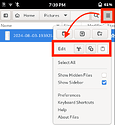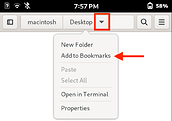Adding to convo with my first-hand experience / success:
- Select file 1 on Librem5 (L5)
- Hamburger icon 2 > Cut
Because I don’t want the file on my phone. “Copy” if want to have file on L5 and another location. - Navigate to shared folder on my Mac 3
- Paste the file(s) 2
Mac Fileshare Setup 
-
Mac > System Preferences > Sharing > File Sharing
-
I used the string of text from my Mac listed under the Sys Prefs section:
Computers on your local network can access your computer at
in the Connect to Server field on the L5 5.
More about File Sharing setup on a Mac.
Librem5 Setup 
- Home screen
- Files icon 4
- Top left icon (opens left-hand panel menu)
- + Other Locations 5
My Specs
- Librem5 US phone with PureOS 10 (Byzantium)
- MacOS Mojave (10.14.6) on an “Early 2013” Pro
Footnotes
1 I found it easiest to do this in List view - toggle the view via bottom right icon in the Files app.
2 Files > top right hamburger icon > cut, copy, and paste options. Icon actions, from left-to-right: Scissors “Cut” … Two boxes “Copy” … Clipboard “Paste”
3 I Bookmarked a location to quickly access later.
4 Currently the default L5 icon is a blue 3-drawer file cabinet with the text “Files” showing underneath.
5 Add network location
All the images in this post were taken on the L5 using Screen Shot (as suggested here), copied to Mac via file share process outlined above, and annotated in Mac’s Preview application (boxes and callouts).
Fun Fact: Article about the “hamburger” menu icon from HowToGeek.




